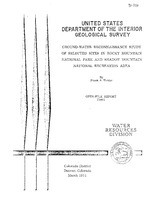An evaluation of the ground-water supply potential at 30 sites within the Rocky Mountain National Park and Shadow Mountain National Recreation Area was made by the U.S. Geological Survey in 1967 and 1968. The work consisted of a geohydrologic reconnaissance, well inventory, and test drilling.
The study sites are underlain by. Precambrian crystalline rocks, Tertiary sediments, or Quaternary glacial and alluvial deposits. The crystalline rocks are generally poor aquifers; however, some wells intercepting fractures may yield as much as 10 gallons per minute from wells 100 to 200 feet deep. Wells drilled in Tertiary sandstones to a depth of 50 to 500 feet may supply 1 to 50 gallons per minute. Wells drilled in unconsolidated glacial and alluvial deposits of Quaternary age yield the largest supplies of ground water in the Rocky Mountain National Park. These deposits commonly can supply 5 to 100 gallons per minute to wells.


